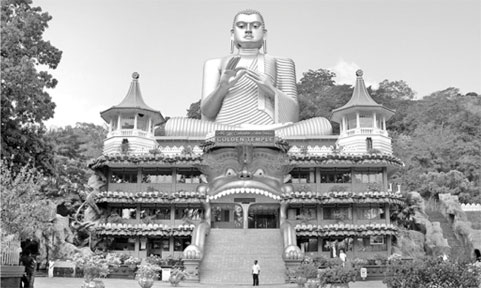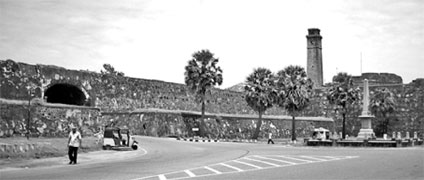A road map for cultural heritage tourism
By Lionel WIJESIRI
|

Golden Temple of Dambulla
|
The historic and cultural resources associated with people, events or
aspects of a country's past give that country its sense of identity and
help tell its story. These resources are the most tangible reflections
of a country's heritage.
The recognition of an area's historic resources can bring about
neighbourhood revitalisation, increased and sustainable tourism,
economic development through private investment, and citizenship
building.
That is why cultural heritage tourism had a key role to play in
tourism development in our country.
What exactly is cultural heritage tourism? Cultural heritage tourism
means travelling to experience the places and activities that
authentically represent the stories and people of the past and present.
It includes irreplaceable historic, cultural and natural resources.
Sri Lanka is gifted with splendid, millennia - old memorials and
cultural artifacts in its ancient cities. The three demarcating points
of the Cultural Triangle are; Kandy Anuradhapura and Polonnaruwa. The
World Heritage Sites are Anuradhapura, Polonnaruwa, Kandy, Dambulla,
Sigiriya, the walled colonial city of Galle; and nature's heritage; the
Sinharaja Rain Forest and the Peak Wilderness.
Outlook
|

Sinharaja Rain Forest |
In 2010, Sri Lanka welcomed 654,000 tourists to the island, an
increase of 46 percent year-on-year, in line with forecasts of a 50
percent increase for the year. Following a strong 2010, 2011 has been
another positive year for Sri Lankan tourism. Arrivals over the first
nine months of the year stand at 598,000, up by 34.3 percent
year-on-year. With November and December historically being strong
months for inbound tourism, analysts forecast a 40 percent growth in
tourist arrivals for 2011 as a whole. This should take tourist arrivals
to about 914,000. (Sri Lanka crossed the 750,000 figure a few weeks ago)
It is believed that the outlook is still bright for Sri Lanka's
tourism and a forecast is made for a 55 percent rise in tourist arrivals
to 1.42 million over the newly extended forecast period to 2016. Income
from tourists should increase from US$575.00 million in 2010 to over one
billion US dollars by 2016.
One challenge is ensuring that tourism does not destroy the very
heritage that attracts visitors in the first place. Tourism is a
competitive, sophisticated, fast-changing industry that presents its own
challenges. It is generally a clean industry: no smokestacks or
dangerous chemicals. But it does put demands on the infrastructure - on
roads, airports, water supplies and public services such as police and
fire protection.
Experiences
Who is the cultural heritage tourism traveller? One who seeks travel
experiences that broaden and deepen his or her understanding of other
places and people can be termed a cultural heritage traveller. Perhaps
tired of the sameness of strip malls everywhere, today's traveller, it
seems, is in search of the genuine or authentic experience of a country
- in other words, what makes a community special.
Interestingly, visitors to historic sites and cultural attractions
stay longer and spend more money than other types of tourists. However,
perhaps the biggest benefits of cultural heritage tourism, is
diversification of local economies and preservation of a community's
unique character.
Because of the benefits, governments stimulate heritage tourism - by
financing the conservation of cultural resources, providing financial
resources for protection, marketing and promotion, improving authentic
visitors' experience, and helping earn higher revenue from the cultural
resources achieving economic and social benefits, providing financial
resources for protection, as well as marketing and promotion. While
tourism operators, heritage managers and communities have their own
views and needs, there is a broad range of common interests and great
potential for mutual benefit. Of common interest to all are providing
appropriate public access, presenting and protecting the significance of
places, and the need for sustainability - sustainability for businesses,
for heritage places, and for the community.
Road map
|

Galle Fort |
The following principles have been derived from the international and
national context of sustainable practice in both tourism and heritage.
* Recognise the importance of heritage places
A great deal of tourism relies on places with natural, indigenous and
historic significance as fundamental assets on which tourism products
are based. Recognising, describing, understanding and communicating
significance is an essential part of heritage conservation and
responsible tourism at heritage places. Understanding significance makes
good business sense for tourism - it is one of the key selling points
for products.
Tourism needs to be planned carefully to be appropriate to the
significance of a place. Tourism will not be an option for some heritage
places where it is incompatible with the significance or management
objectives of a place.
To respect the cultural significance of places, people involved in
tourism need to be sensitive to, and directly involve, cultural groups
who have a special interest in them.
*Look after heritage places
Heritage conservation is a concern of responsible tourism. It ensures
the long-term protection of heritage assets. The aim of heritage
conservation is to retain the natural and cultural significance of
places.
Each heritage place or area has its own particular significance and
requirements for conservation. It is the responsibility of people
planning tourism activities at heritage places to take all reasonable
steps to avoid an impact on the natural and cultural significance of a
place.
* Develop mutually beneficial partnerships
Developing active partnerships, alliances and open lines of
communication between tourism operators, site managers, other
businesses, local communities and indigenous people is the best way to
build a sustainable tourism operation. Success depends on building
relationships and, where appropriate, forming partnerships of benefit to
both tourism and heritage.
Working with local people in the management, presentation and
operation of tourism activities will foster ownership and understanding
and contribute to positive outcomes for the visitor attraction and local
community. Developing partnerships with indigenous custodians is crucial
in the case of presenting indigenous heritage.
* Incorporate heritage issues into business planning
As with all business operations, sound business planning is the
essential foundation of a successful heritage tourism operation.
A business plan will clearly establish the nature and purpose of the
operation and how it will achieve business and heritage objectives. It
is important to measure progress toward your objectives and adjust the
plan if necessary.
A business plan which incorporates business and heritage objectives
can be used to build support in business and heritage sectors. Ongoing
research on the significance of places and visitor markets should be
used to improve the targeting, marketing and protection of the product
and inform reviews of business plans.
* Invest in people and places
Tourism involving heritage places should contribute to the
conservation of heritage assets and to the economic and social
well-being of local communities. Strategies which bring mutual benefits
can be developed to benefit the place, the people involved and the local
and regional community.
These can include increasing use of local goods and services,
providing corporate contributions to conservation initiatives, technical
assistance, training and education programs, direct involvement in
management or upgrade of visitor facilities, improved visitor
understanding of the significance of a place, or helping achieve other
goals that the local community supports.
* Market and promote products responsibly
The significance of heritage places can be the basis for product
definition in marketing and promotion.
The marketing and promotion of heritage places needs to recognise and
respect their identified significance and the wishes of local
communities - and not create unrealistic visitor expectations.
A balance needs to be found between meeting tourism needs for
marketing, promotion and product positioning, heritage needs such as
planning for the future use of places and appropriate use of images and
the needs of visitors for accurate information.
* Provide high quality visitor experiences
Providing an enjoyable and enriching experience for visitors is the
goal of everyone involved in heritage tourism. A common understanding of
visitor needs and motivations by tourism operators and heritage managers
is the basis for providing high quality visitor experiences.
High customer satisfaction is achieved through providing enjoyment
for visitors, along with understanding of a place. Attention to detail
and a commitment to high quality in the planning of activities, staff
training, interpretation and provision of facilities and services will
generate positive effects for businesses and heritage places. |

